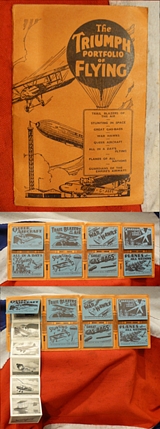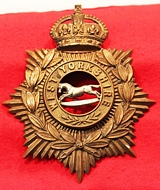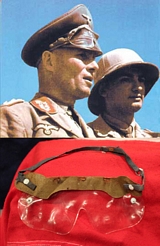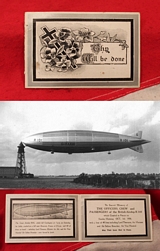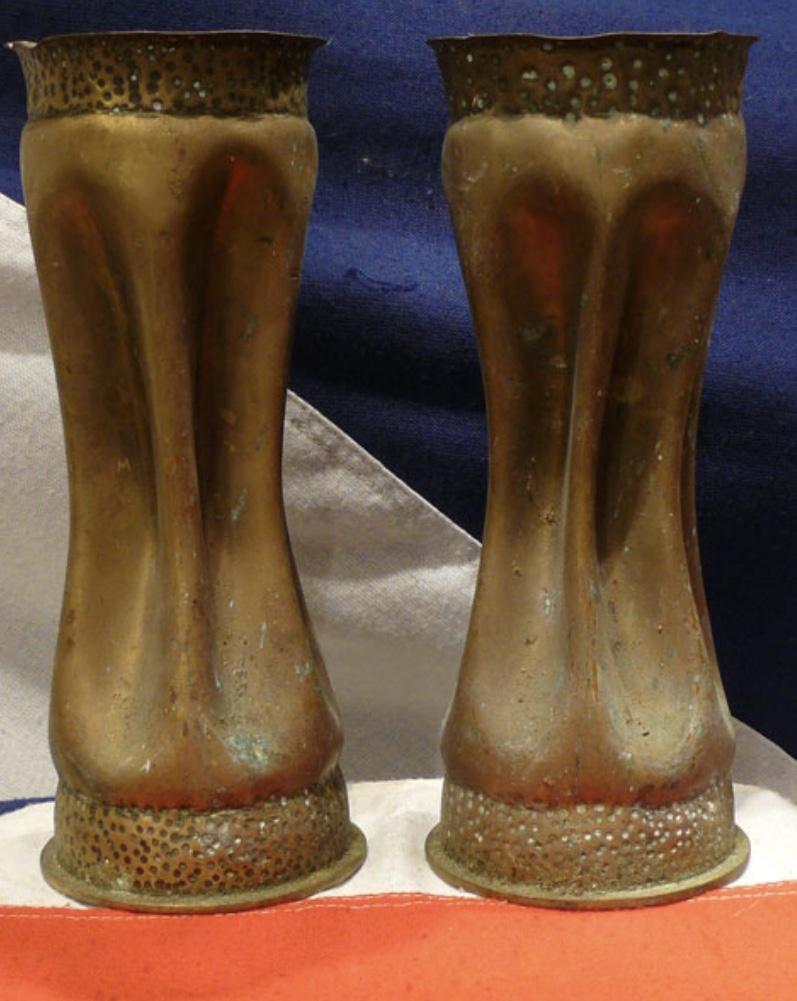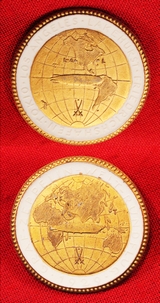WW1 / WW2 / 20th Century
Rare, Complete and Original, Triumph Magazine Portfolio of Flying
Original 1930's issue. Softcover, in exceellent condition, about 3.5 x 5.25 inches but folds out to about 14 x 5.25 inches, folds out to 4 panels with each panel have two small booklets (about 3 x 2 inches each), each booklet contains 7 small b&w photos or illustrations, the booklets are as follows: Queer Aircraft ( glider plane; Westland-Hill Pterodactyl 3 seater; Northrop Beta monoplane; Focke Wulf; Cierva autogiro; seaplane; mono-spar 3 seater ), ---All in a Days Flying ( iceberg patrol; aerial mountie gets his man; stemming the stampede; answering an SOS; Air Mail; the flying shop (delivering goods to natives); rescuing stranded mountaineers ) ---Trail Blazers of the Air ( Charles Lindbergh; Richard Byrd; J A Mollison; Charles Kingsford-Smith; Bert Hinkler; Amy Johnson; Alan Cobham ) ---Stunting in Space ( wing walkers, acrobats, dare devils; etc ) ---War Hawks ( a zeppelin hunter; machine gunning the artillery; dog fight; British blimp bombs a submarine; destroying an observation balloon; etc) ---Great Gas Bags ( the Graf zeppelin; Picard's Stratosphere balloon; USS Akron; jumping balloon; Spanish observation balloon; American airship moored; a plane carrying airship ) ----Guardians of the Empire's Airways ( fighter taking off from aircraft carrier Furious; 20 ton RAF monoplane; Blackburn Napier torpedo plane; desert patrol; loading a bomber; getting an RAF searchlight ready; catapulting a plane from a submarine ) ---Planes of all Nations ( Belgian fighter; british 38 seaterand Puss Moth; French Paris to London liner; Italian S.55 flying boat; Junker; Swiss Dornier Do-X; American military transport plane ), read more
140.00 GBP
An Edwardian West Yorkshire Regt. Large Helmet Plate
World War I saw numerous battalions of The Prince of Wales's Own (West Yorkshire Regiment) serving at Neuve-Chappelle, Loos, the Somme, Passchendaele, Ypres, Marne, Arras, Cambrai and Gallipoli. At its peak The West Yorkshire Regiment numbered 37 battalions, 66 Battle Honours were bestowed and four Victoria Crosses were awarded.
The four TF battalions formed the West Yorkshire Brigade, which mobilised as 146 Brigade, 49th (West Riding) Infantry Division on the outbreak of World War I and served in France 1915?18. They raised duplicate battalions (2/5th, 2/6th, 2/7th, 2/8th) that constituted 185 Bde in 62nd (2nd West Riding) Division, which also served in France 1917?18. In 1915 they formed further reserve battalions (3/5th, 3/6th, 3/7th, 3/8th) Battle honours in WW1 The Great War [31 battalions]: Aisne 1914 '18, Armenti?res 1914, Neuve Chapelle, Aubers, Hooge 1915, Loos, Somme 1916 '18, Albert 1916 '18, Bazentin, Pozi?res, Flers-Courcelette, Morval, Thiepval, Le Transloy, Ancre Heights, Ancre 1916, Arras 1917 '18, Scarpe 1917 '18, Bullecourt, Hill 70, Messines 1917 '18, Ypres 1917 '18, Pilckem, Langemarck 1917, Menin Road, Polygon Wood, Poelcappelle, Passchendaele, Cambrai 1917 '18, St. Quentin, Rosi?res, Villers Bretonneux, Lys, Hazebrouck, Bailleul, Kemmel, Marne 1918, Tardenois, Amiens, Bapaume 1918, Drocourt-Qu?ant, Hindenburg Line, Havrincourt, ?p?hy, Canal du Nord, Selle, Valenciennes, Sambre, France and Flanders 1914-18, Piave, Vittorio Veneto, Italy 1917-18, Suvla, Landing at Suvla, Scimitar Hill, Gallipoli 1915, Egypt 1915-16 read more
220.00 GBP
A Pair of WW2 Gas Shield Eye Protectors, Afrika Korps Dessert Campaign Souvenirs, 'Rommel' Type
Made for the British forces in the earliest part of the war, initially as gas protectors, but actually soon realised to be far better as sand storm eye protection, made of an early form of clear celluloid with elastic.
Used to great effect by our so-called Desert Rats in North Africa, but many were captured in the early part of the war in Afrika by the German forces, and re-issued and used by them. In fact Rommel used the very same protectors for that purpose as one can see from the numerous photos of Rommel taken in Africa.
Part of a collection of Afrika Korps campaign souvenirs, including the tinted celluoid goggle type, and a complete pack of goggles, in all original packing, very rare to survive complete packet and contents read more
55.00 GBP
A Fine & Original Chapka Plate for the 9th Royal Lancers WW1 Issue
With all battle honours up to the Boer War. The last Lancer regiment to engage in Lance on Lance combat in WW1. The chapka was a type of helmet worn by 19th century Polish light cavalry and later adopted by another nations, including Britain.
During the Second Boer War, 1899-1902, the Lancers took part in the following actions: Belmont, Battle of Modder River, Magerfonstien, Relief of Kimberley, and the following Battle of Paardeberg which resulted in Cronje?s surrender. They provided Lord Roberts? escort for his state entry into Bloemfontein. After the war, the 9th returned to Sialkot in the Punjab Although engaged in combat for the whole of the war the Lancers only operated as a cavalry unit during 1914. This was due to the widespread use of machine guns and shelling and also the advent of the tank. For the remainder of the war they operated as infantry in the trenches.
Notable events included a Victoria Cross for Captain Francis Octavius Grenfell for his actions in saving the guns of 119th Battery, Royal Field Artillery on 24 August 1914 (he was later killed in action on 24 May 1915, as was his twin brother, Riversdale, a yeomanry officer who attached to 9th Lancers), and the regiment's participation in the final "lance on lance" action of the First World War on 7 September 1914 at Moncel in which Lieutenant Colonel David Campbell led a charge of two troops of B Squadron and overthrew a squadron of the 1st Guard Dragoons. After Campbell left on promotion he was replaced as commanding officer by Desmond Beale-Browne.
.
By the end of the war 274 Lancers had died.
In August 1914 Hume's regiment was in Belgium with the British Expeditionary Force (BEF). On 24 August during the Battle of Mons, they charged a large body of German infantry who were advancing to encircle the 5th Division at Audregnies. This famous action saw Captain Francis Grenfell win the Victoria Cross. The 9th Queen's Royal Lancers, or the Delhi Spearmen, were a cavalry regiment of the British Army. They are best known for their roles in the Indian mutiny of 1857, the WW1 Charge at Mons, and for their part in the North African campaign of World War II including the retreat to and the battle of El Alamein in 1942.The 9th Queen's Royal Lancers were originally formed during the Jacobite Risings in 1715. They were formed by Major-General Owen Wynne and were the second cavalry regiment in the British Army. They were initially known as the "9th Dragoons" or "Wynne's Dragoons". In 1717, the regiment embarked for Ballinrobe, in Ireland, and was placed on the Irish establishment.
In 1783 they converted into Light Dragoons, becoming the 9th Light Dragoons, and served in the Irish Rebellion of 1798, Sir Samuel Auchmuty's expedition to the River Plate in 1803, the occupation of Montevideo and Wellington's Peninsula War between 1811 and 1813.
In 1816 they were constituted Lancers and in 1830 were given the distinguished title of "Queen's Royal", in honour of Queen Adelaide, consort of William IV, hence becoming the 9th Queen's Royal Lancers.
The Lancers were first posted to India during the Gwalior Campaign of 1843. They subsequently took part in the First Anglo-Sikh War of 1845-46 and the Second Anglo-Sikh War of 1848-49 where they were often led by Sir Hope Grant and were the first recipients of the Bronze Star Medal.
During the Indian mutiny of 1857, the 9th Lancers earned the name the Delhi Spearmen, a name which is believed to have been given to them by the mutineers themselves. 9th Lancers was present in all three of the most notable events associated with the Indian mutiny, namely, the seizure of Delhi, the seizure of Lucknow and the relief of Lucknow. For their actions the Lancers were awarded twelve Victoria Crosses, more than any other cavalry regiment. They were described by an ally as:-
"The beau ideal of all that British Cavalry ought to be in Oriental countries". read more
295.00 GBP
An R.101 Airship Catastrophe Crash Memorial Service Card
On October 5, 1930, the British airship R.101 crashed on a hill in Beauvais, France. The impact was gentle and survivable but the ship was inflated with hydrogen, and the resulting fire incinerated 46 of the passengers and crew. Two additional crew members died of their injuries soon after. The ship had never been flown at full speed, or on all engines, or in bad weather. But on October 4, 1930, the ship was dispatched to fly on all engines into a known storm, at a time of year known for bad weather, despite the recommendation of airship officers and meteorology experts.
After struggling to maintain altitude over England and the Channel the ship crossed into France, where rain and wind damaged the unrepaired fabric at the nose of the ship and broke open gas bags in the bow, releasing the ship?s lifting gas. The overloaded and under-ballasted ship settled into a hillside in northern France and moments later the ship?s hydrogen erupted into flame. Calcium flares in the control car may have ignited, activated by exposure to water, but whatever the source of ignition, the fire destroyed the ship in minutes and killed most of those onboard, including Lord Thomson. read more
35.00 GBP
1928 Graf Zeppelin Plaque of the LZ127 Graf Zeppelin. By Heinrich & Co.
A Rare 1928 Graf Zeppelin Porcelain Wall Plaque
Depicting the LZ127 Graf Zeppelin. By Heinrich and Co. Inscribed on the reverse Forrngebung Fachoberiehrer, W-Veit Decoration Facheihrer Otto Keitel, Entwurf begutachtet una genehmigt von der Luftshiffbau Zeppelin Gmbh Friedrichshafen 1928, Ges Geschutzt -- 9.75in. (25cm.) diameter
The LZ-127, Graf Zeppelin, was arguably the most important zeppelin ever, the airship that put post WW I German aviation back on the map. Ferdinand Graf von Zeppelin inaugurated German lighter-than-air aviation at the turn of the 20th Century. His zeppelins caught the German public?s imagination, and they became extremely popular. During WW I, his zeppelins flew for both the Army and Navy. Once more, the zeppelins caught the German people?s imagination. Even civilians and military officers who were bombing targets, both on the continent and in England, were impressed by the giant machines. Graf von Zeppelin died in 1917, and his company, which passed to Hugo Eckner?s management, faced difficult times in post WW I Germany. As a part of Germany?s war reparations, the Zeppelin Company built and delivered the LZ-126 (eventually renamed the U.S.S. Los Angeles) to the U.S. Navy in 1924. Eckner personally commanded the LZ-126 on the flight to the U.S. The engendered excitement allowed the company to build the LZ-127, eventually known as the "Graf Zeppelin." It was placed in service in 1928.
The Graf Zeppelin remained in service from September 1928 until a month after the Hindenburg exploded in New Jersey in May 1937. During this time, the "Graf Zeppelin" flew almost six hundred flights and covered more than one million miles. With the destruction of the "Hindenburg," the zeppelin era sadly came to an end. During her nine years of flight, the LZ-127 circled the globe, flying from Europe to the USA and on to Asia. She even had numerous voyages to South America. It was travel on a grand scale for less-than-thirty lucky people at a time. A crew of about twenty-four served the passengers. Trips from Germany to the U.S. were much faster than any other vessel of the time. Life aboard the "Graf Zeppelin" was very gracious. read more
875.00 GBP
A Very Rare Long Distance Flight Medal, Major von Parseval 1909
GERMANY. Medals by Karl Goetz. Silver medal 1909.. On the major's long-distance airship trips, e.g. D. August of Parseval. Half-length portrait to the left. rev. Eagle with outstretched wings on airship. by K.Goetz . Bayer Huptmunzamt Feinsilber.
Designed by world renown medalist Karl Goetz [1875 - 1950]
Very Rare silver medal, for the flight of 12th to 19th October, 1909. Long-distance voyages of the Parseval airships. Half-length portrait of the airship designer A. Parseval to the left / eagle stands with outstretched wings on the bow of the airship, below water surface, above right inscription. Hallmark: feinsilber BAYER. MAIN MINT OFFICE. it was awarded in two grades silver and bronze, this, the silver is an incredibly rare antique aviation medal from the earliest days of airships. August von Parseval (5 February 1861, in Frankenthal (Pfalz) – 22 February 1942, in Berlin) was a German airship designer.
As a boy, Von Parseval attended the Royal Bavarian Pagenkorps in Munich from 1873 to 1878, where he took the Fähnrichexamen (cadet exams). He then joined the Royal Bavarian 3rd Infantry Regiment Prinz Carl von Bayern. An autodidact, he busied himself with the problems of aeronautics. In the garrison town of Augsburg he came into contact with August Riedinger and also came to know his later partner Rudolf Hans Bartsch von Sigsfeld, with whom he developed Drachenballons: balloons used by the military for observation.
In 1901 Parseval and Sigsfeld began building a dirigible airship. After Sigsfeld's death during a free balloon landing in 1902, the work was interrupted until 1905.
By 1905, thanks to improvements in motor design, an appropriate engine was now available. His designs were licensed to the British Vickers company. Up to the end of the First World War, 22 Parseval airships (both non-rigid (blimps) and semi-rigid (with keels)) were built. In the late twenties and early thirties, four more semi-rigid airships were built in accordance with the "Parseval-Naatz principle". read more
645.00 GBP
A Good WW1 14/15 Star 'South African' Trio With Transvaal Scottish Badge
8th Infantry, and further badges. All medals named. He served in the 7th and 8th Infantry. British TOE in April, 1916:
1st Division (Major General AR Hoskins)
1st East African Brigade- 2nd Loyal North Lancs, 2nd Rhodesia Regiment, 130th Baluchis, 3rd Kashmir Rifles/3rd KAR (Composite Batt)
2nd East Afican Brigade- 25th Royal Fusiliers, 29th Punjabis, 129th Baluchis, 40th Pathans
Divisional Troops- 17th Indian Cavalry (one squadron), East African Mounted Rifles, King's African Rifles Mounted Infantry (one company), East Africa Pioneer Corps (Mounted Section), 27th Mountain Battery, 5th Battery South African Field Artillery, # 6 Battery (four 12 pdrs manned by 2nd LNL), # 7 Battery (four 15 pdrs), 38th Howitzer Brigade (one section of two 5" Howitzers), Willoughby's Armored Car Battery, 2nd LNL Machine-gun Company.
2nd East African Division (Major General J Van Deventer)
1st South African Mounted Brigade- 1st SA Horse, 2nd SA Horse, 3rd SA Horse, 8th SA Horse (forming SA).
3rd South African Infantry Brigade- 9th SA Infantry, 10th SA Infantry, 11th SA Infantry, 12th SA Infantry.
Divisional Troops- South African Scout Corps, 28th Mounted Battery (six 10 pdrs), 2nd Battery SA Field Artillery (four 13 pdrs), 4th Battery SA Field Artillery (four 13 pdrs), # 12 Howitzer Battery (two 5" Howitzers), East African Volunteer Machine-gun Company.
3rd East African Division (Major General C Brits)
2nd South African Mounted Brigade- 5th SA Horse, 6th SA Horse, 7th SA Horse, 9th SA Horse
2nd South African Infantry Brigade- 5th SA Infantry, 6th SA Infantry, 7th SA Infantry, 8th SA Infantry
Divisional Troops- 1st Battery SA Field Artillery (four 13 pdrs), 3rd Battery SA Field Artillery (four 13 pdrs), 38th Howitzer Brigade (one section of two 5" Howitzers), # 5 Light Armoured Car Battery
Photos of soldiers of the Transvaal Scottish for information only, not included with the medals read more
245.00 GBP
An Iconic Example of Now Highly Collectable Military Artwork of WW1. German Artillery Shell Trench Art Vases Dated August 1917
In need of tender hand polishing that would reveal superb results. 9 inches high
Trench art objects are holders of soldiers’ memories and reminders of the conflict they faced. Made out of recycled war refuse such as shell casings, spent bullets or whatever came to hand, they open a window to the past. They tell us things like where soldiers went and what their surroundings were like. They also give hints about soldiers’ thoughts and actions. Something as simple and functional as a matchbox cover can provide a map of a soldier’s movements while other, more decorative examples, show a desire to find and create beauty, to camouflage war in art
Trench art can be made of any number of things. Many objects were made out of the scraps created by war. This included ammunition shell cases, bullet casings, shrapnel, and pieces of destroyed buildings or downed planes. These materials would all have been readily available in the war zones to soldiers, their prisoners of war and to civilians still in the area. Some objects appear to have little to do with the war full stop. Turkish prisoners of war started a bustling business in objects made of glass beads which commemorated the war. read more
140.00 GBP
A Very Fine Quality Meissen Porcelain Round the World Medal
A rare and most desireable medal a most fine collectors piece 1929 Graf Zeppelin World Flight Medal. White bisque porcelain, and gilt 48mm.
Obv. Airship over Eastern
Hemisphere globe, GRAF ZEPPELIN WELT
RUNDFLUG . Rev. Airship over Western Hemisphere globe, FRIEDRICHSHAFEN. TOKIO. LOS ANGELES. LAKEHURST . A classic Zeppelin
issue made by the State Porcelain Factory of Meissen, mintmark crossed swords. The tour began in Friedrichshafen, Germany, where the Graf Zeppelin was built, and continued on to Tokyo, Los Angeles, and Lakehurst, NJ (where her sister ship, the Hindenburg, exploded in May 1937) before returning to Germany. read more
265.00 GBP


